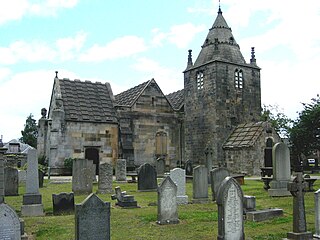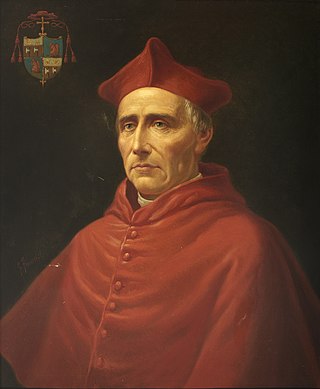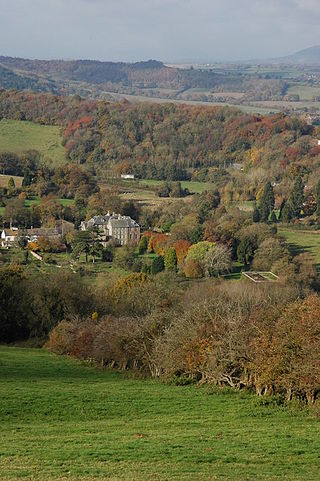
Thomas Howard, 2nd Duke of Norfolk, styled Earl of Surrey from 1483 to 1485 and again from 1489 to 1514, was an English nobleman, soldier and statesman who served four monarchs. He was the eldest son of John Howard, 1st Duke of Norfolk, by his first wife, Catharina de Moleyns. The Duke was the grandfather of both Queen Anne Boleyn and Queen Katherine Howard and the great-grandfather of Queen Elizabeth I. In 1513, he led the English to victory over the Scots at the decisive Battle of Flodden, for which he was richly rewarded by King Henry VIII, then away in France.

Roger Northburgh was a cleric, administrator and politician who was Bishop of Coventry and Lichfield from 1321 until his death. His was a stormy career as he was inevitably involved in many of the conflicts of his time: military, dynastic and ecclesiastical.

Corstorphine is an area of the Scottish capital city of Edinburgh. Formerly a separate village and parish to the west of Edinburgh, it is now a suburb of the city, having been formally incorporated into it in 1920.

Christopher Bainbridge was an English cardinal. Of Westmorland origins, he was a nephew of Bishop Thomas Langton of Winchester, represented the continuation of Langton's influence and teaching and succeeded him in many of his appointments such as provost of The Queen's College in the University of Oxford. Towards the end of the reign of King Henry VII, he was successively Master of the Rolls, a Privy Counsellor, Dean of Windsor and Bishop of Durham. Becoming Archbishop of York and therefore Primate of England in 1508, he was sent as procurator of King Henry VIII to the papal court of Pope Julius II, where he was active in the diplomatic affairs leading to Henry's war against France and took part in the election of Julius's successor, Pope Leo X. He was murdered by poisoning in Italy in 1514 and was succeeded as Archbishop of York by Thomas Wolsey.

John Waltham was a priest and high-ranking government official in England in the 14th century. He held a number of ecclesiastical and civic positions during the reigns of King Edward III and Richard II, eventually rising to become Lord High Treasurer, Lord Privy Seal of England and Bishop of Salisbury. He is buried in Westminster Abbey, London.
Sir George Lauder of the Bass, Knight, was a cleric, Privy Counsellor, and Member of the Scottish Parliament. He was a legal tutor to Prince Henry.
Sir Robert Lauder of Popill was a Scottish landowner and an adherent of Mary, Queen of Scots.
Sir Alexander Lauder of Blyth, Knt. was Provost of Edinburgh almost continually from 1500 to 1513. He was Commissioner to the Scottish Parliament, 1504–06, and an Auditor of the Exchequer in Scotland. He appears to have been on terms of intimacy with the King, James IV, with whom he played cards and to whom he occasionally lent money. "He led the men of Edinburgh to join the King's host" at the battle of Flodden, and fell there.
William Grey was a medieval English churchman, academic, and Lord High Treasurer. He served as Chancellor of Oxford University and as Bishop of Ely.
Sir James Kirkcaldy of Grange, a Fife laird and treasurer of Scotland. He married Janet Melville, aunt of Sir James Melville of Halhill. Their heir was William Kirkcaldy of Grange. His main property was called Hallyards Castle. The name is sometimes spelled Kirkaldy.
John Drummond of Milnab was a 16th-century Scottish carpenter in charge of the woodwork of the palaces, castles and guns of James IV of Scotland and James V of Scotland.
Richard Benese, was a canon of the Augustinian priory of Merton.

Provan Hall is a historic place composed of two buildings built about the 15th century and situated in Auchinlea Park, Easterhouse, Glasgow. It is owned by the National Trust for Scotland and managed by Glasgow City Council. The two parallel buildings, enclosing a courtyard, are protected as a category A listed building.

Sir William Denys of Dyrham, Gloucestershire, was a courtier of King Henry VIII and High Sheriff of Gloucestershire in 1518 and 1526. The surname is sometimes transcribed as Dennis.
John Drummond, 1st Lord Drummond, was a Scottish statesman.

Moubray House, 51 and 53 High Street, is one of the oldest buildings on the Royal Mile, and one of the oldest occupied residential buildings in Edinburgh, Scotland. The façade dates from the early 17th century, built on foundations laid c. 1477.

John de Troye was a Welsh-born Crown official and judge in fourteenth century Ireland, who held the offices of Chancellor of the Exchequer of Ireland and Lord Treasurer of Ireland. He was also a leading ecclesiastic, whose most senior clerical office was Chancellor of St. Patrick's Cathedral, Dublin. He was a notable pluralist.
Richard Rawson was Archdeacon of Essex from 1503 and a Canon of Windsor from 1523 to 1543 He was the son of Richard Rawson, a merchant of London and his wife Isabella Craford, and a younger brother of John Rawson, 1st Viscount Clontarf, Lord Treasurer of Ireland. He received his Bachelor of Canon Law at Cambridge in 1490, followed by a presumed doctorate from the University of Bologna.

Baron of Lundie is a nobility title in the Baronage of Scotland.

Thornton Castle was a Scottish fortress belonging to the Montgomery family and subsequently Lord Home near Innerwick in East Lothian.










